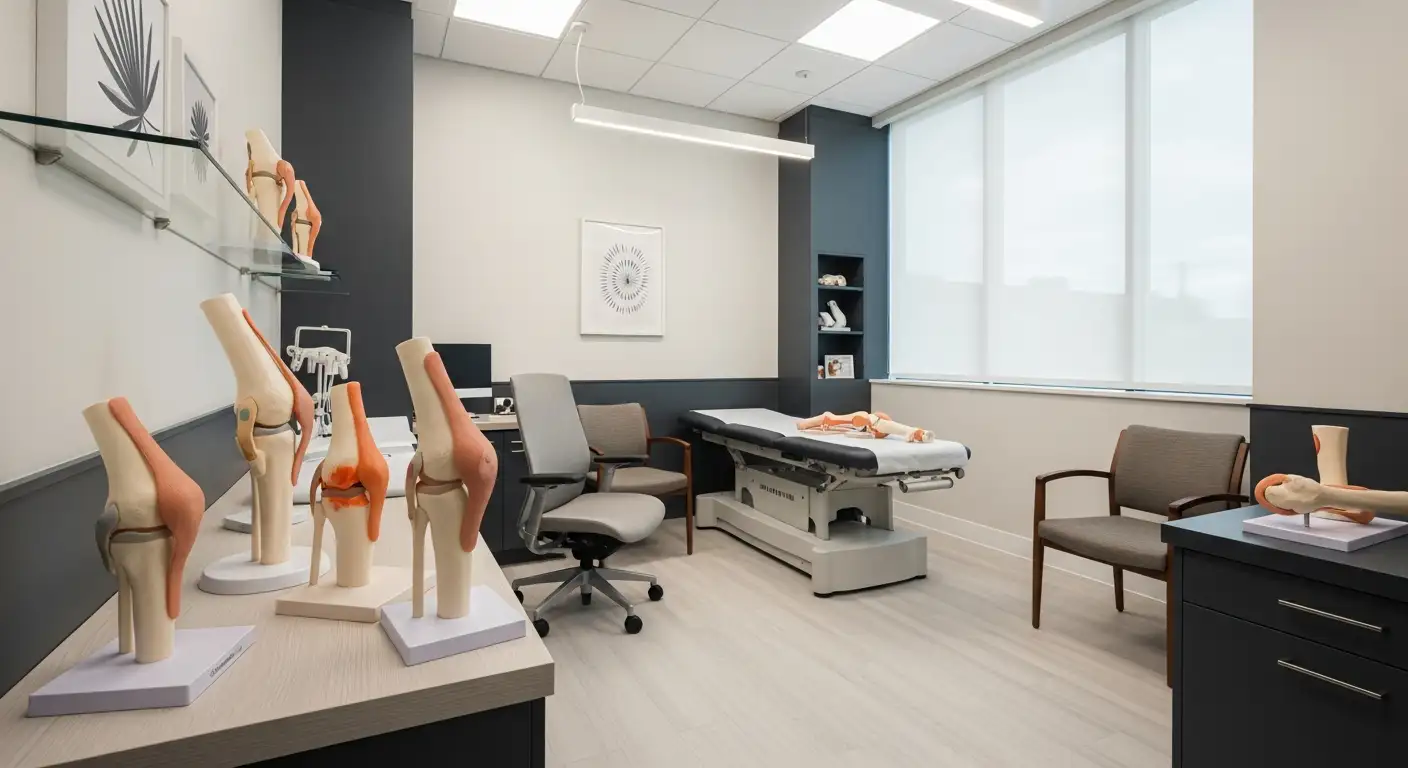Exploring the Critical Link Between Knee Health and Mobility
Knee pain is a widespread condition affecting people across all age groups, significantly influencing overall mobility and daily functioning. This article delves into how knee discomfort hampers movement, the causes behind it, progression over time, and the latest insights into effective management strategies to restore and maintain mobility.
Understanding How Knee Pain Affects Overall Mobility

How does knee pain impact overall mobility and daily activities?
Knee pain can greatly hinder a person’s ability to move freely. It often makes basic activities like walking, standing, sitting, and climbing stairs difficult or even impossible. When knees hurt, people may avoid movement altogether to prevent discomfort, leading to reduced activity levels.
This decrease in movement can affect independence, especially in older adults. Tasks such as grocery shopping, cleaning, or caring for oneself may become challenging, which can impact quality of life.
The severity and duration of pain are important factors. Mild discomfort might be manageable, but intense pain can limit mobility drastically. Chronic knee pain—that lasts for months or years—can be particularly debilitating, leading to muscle weakness, joint stiffness, and further functional decline.
Conditions like osteoarthritis are common causes of long-term knee pain, contributing to ongoing mobility issues. Patients may experience difficulty walking long distances, standing for extended periods, or even performing recreational activities.
To combat these effects, various treatments are available. Medications, physical therapy, supportive devices, and sometimes surgery aim to reduce pain and improve function. Despite these interventions, persistent or severe pain can still significantly influence daily routines and emotional health.
Ultimately, managing knee pain is essential to preserve mobility and maintain a good quality of life. Early diagnosis and tailored treatment strategies can help minimize its impact and aid individuals in staying active and independent.
Causes and Symptoms of Knee Pain That Affect Mobility
Knee pain affecting mobility arises from various causes, encompassing both injuries and chronic medical conditions. Common injuries include ligament tears such as anterior cruciate ligament (ACL) injuries, meniscal tears, fractures, and dislocated kneecaps. Overuse conditions like tendinitis and bursitis are also significant contributors, often resulting from repetitive movements or strain.
In addition to injuries, several medical conditions can impair knee function. Osteoarthritis, rheumatoid arthritis, gout, and pseudogout are primary degenerative or inflammatory diseases that cause swelling, stiffness, and pain in the knee joint. These conditions tend to worsen with activity and can lead to persistent discomfort.
The symptoms associated with knee pain vary but frequently include noticeable swelling, stiffness, warmth, redness, and a feeling of instability. Weakness in the knee, along with popping or clicking sounds during movement, is common. Patients often experience difficulty fully straightening or bending the knee, which impacts walking and other daily activities.
In cases of acute injury, symptoms may appear suddenly with severe pain, bruising, and an inability to bear weight. Chronic conditions usually cause ongoing discomfort that hampers mobility over time.
Recognizing these signs is essential for early diagnosis and treatment to prevent further joint damage and maintain independence in movement. Medical assessment, often involving physical examination and imaging tests, helps determine the specific cause and guides appropriate management strategies.
Progression of Knee Conditions and Their Impact on Mobility

What is the progression of knee conditions and their effects on mobility over time?
Knee conditions, especially osteoarthritis (OA), tend to progress gradually over many years. Early stages often involve mild symptoms such as slight discomfort, stiffness, or occasional swelling. At this point, many individuals can still carry out everyday activities without significant difficulty.
As the condition advances, further deterioration of joint structures occurs. Cartilage wears down, leading to joint space narrowing visible on X-rays. Bone spurs, or osteophytes, may develop around the joint, contributing to pain and stiffness. These structural changes cause symptoms to become more frequent and intense, often resulting in difficulty walking, climbing stairs, or standing for extended periods.
In the later stages, joint instability and deformity become evident. The cartilage loss exposes bones to friction, resulting in increased pain that can even be present at rest. Reduced range of motion and joint swelling are common, significantly impairing mobility.
These progressive changes mean activities that once seemed simple, like getting out of a chair or crossing a room, become challenging. The persistent pain and joint limitations may also lead to decreased activity levels, muscle weakness, and overall decline in functional independence.
When conservative treatments are no longer effective, many patients require surgical options such as knee replacement. This procedure aims to restore joint function, reduce pain, and improve mobility, highlighting the importance of early intervention and management to slow disease progression.
Treatment Strategies and Management for Improved Mobility

What treatment options and management strategies are available to improve mobility in individuals with knee pain?
Addressing knee pain and restoring mobility requires a multifaceted approach tailored to the specific cause and severity of the condition. Regular exercise plays a crucial role; activities like strength training, flexibility exercises, and low-impact sports such as swimming, cycling, yoga, or tai chi help support joint health, reduce stiffness, and improve range of motion.
Maintaining a healthy weight is another important strategy, as excess weight puts additional stress on the knee joints, which can worsen pain and accelerate degenerative processes like osteoarthritis. Proper footwear and correct posture help ensure proper joint alignment, reducing the risk of further injury.
Pain management often involves medications such as NSAIDs to reduce inflammation and discomfort. In some cases, injections like corticosteroids or hyaluronic acid can provide targeted relief. Surgical options like arthroscopy, ligament repair, or knee replacement might be necessary if structural damage is significant.
Lifestyle modifications include avoiding excessive activity or overexertion, recognizing early signs of injury, and adopting habits that protect the knees. Supportive devices—such as braces, orthotics, or mobility aids—can also enhance stability and safety.
Engaging with healthcare professionals, especially physiotherapists, ensures personalized treatment plans. Physiotherapy focuses on manual therapy, soft tissue mobilization, strengthening, and restoring joint function. Regular monitoring of symptoms and adapting activities accordingly can lead to sustained improvements in mobility and quality of life.
Physiological and Anatomical Links Between Knee Pain and Mobility Impairment
What physiological and anatomical mechanisms link knee pain to mobility impairment?
Knee pain and mobility issues are connected through complex physiological and structural mechanisms within the joint.
The knee joint comprises bones such as the femur, tibia, and patella, along with cartilage, ligaments, and tendons that support movement and load-bearing. When these structures are injured or degenerated—due to arthritis, ligament tears, or cartilage damage—pain signals are triggered. This pain often prompts reflex muscle guarding, where muscles around the knee stiffen to protect the joint, limiting its movement.
This muscle guarding can lead to reduced joint range of motion and instability, which impacts gait and daily activities. Additionally, pain and inflammation affect the normal biomechanics of the knee. Healthy joint motion involves accessory movements like rolling, gliding, and spinning of the joint surfaces. Damage or inflammation disrupts these motions, resulting in stiff, inefficient movement patterns.
Beyond structural changes, biomechanical factors play a significant role. Conditions such as joint malalignment or increased load due to obesity place extra stress on damaged tissues, accelerating deterioration and further impairing mobility.
Neural pathways also contribute. Pain alters nerve signaling, influencing muscle activation and coordination. Manual therapies such as joint mobilizations aim to restore normal joint mechanics, relieve pain, and promote better movement patterns.
These interventions help modulate neural pathways that control muscle activity and joint stability, ultimately improving functional mobility and reducing pain.
Understanding these interconnected mechanisms underscores the importance of comprehensive treatment strategies focusing on both structural repair and neural pathway modulation to restore knee function.
Scientific Insights on Knee Pain and Mobility Outcomes
What scientific insights exist regarding the relationship between knee pain and mobility outcomes?
Research has consistently shown that knee pain, especially when caused by osteoarthritis (OA), is strongly associated with limitations in mobility and daily functioning. Studies reveal that pain hampers essential activities like walking, climbing stairs, and maintaining balance, which are vital for independence.
The connection between pain and mobility isn't straightforward. While pain often leads to decreased physical activity — increasing the risk of muscle weakness and joint stiffness — some findings suggest psychological factors such as fear of pain or movement, along with catastrophizing thoughts, can further decrease activity levels and worsen functional decline.
Structural joint changes, including swelling, cartilage loss, and decreased muscle strength, serve as mediators that translate joint damage into mobility restrictions. As cartilage degenerates, the joint becomes stiff, and the pain intensifies, creating a cycle that exacerbates functional impairments.
Long-term studies indicate that individuals experiencing persistent knee pain face a higher chance of developing sustained functional decline and disability. The risk escalates with the severity of joint degeneration and is compounded by biomechanical issues such as altered gait patterns or joint instability.
Biomechanical assessments emphasize how altered movement patterns, muscle weakness, and joint lesions contribute to ongoing pain and mobility problems. These insights underscore the importance of comprehensive evaluation and interventions that address both structural and psychological factors to improve mobility outcomes.
The Effect of Age on Knee Pain's Impact on Mobility

How does age influence the impact of knee pain on mobility?
As people age, the effects of knee pain on mobility tend to become more pronounced. This is largely due to degenerative changes within the joints, such as cartilage thinning, increased stiffness of ligaments, and reduced flexibility. These natural aging processes make the joint less resilient and more susceptible to injuries and conditions like osteoarthritis.
Older adults are particularly vulnerable to osteoarthritis, a degenerative joint disease that causes cartilage breakdown, pain, swelling, and reduced mobility. The progression of this condition can lead to joint instability and difficulty in performing daily activities.
Research indicates that the severity of knee pain correlates closely with activity limitations in the elderly. Severe pain in older adults often results in decreased activity levels, muscle weakness, and impaired balance, which further increase the risk of falls and injuries.
Lifestyle factors also influence this relationship. Excess weight puts additional stress on aging knee joints, worsening pain and mobility issues. Conversely, maintaining a healthy weight and engaging in regular, low-impact exercise can help preserve joint function and reduce pain.
In summary, with advancing age, joint degeneration accelerates, and knee pain's impact on mobility intensifies. Factors like obesity and activity habits can either worsen or mitigate these effects, highlighting the importance of tailored strategies for managing knee health in older populations.
The Role of Physiotherapy and Interventions in Restoring Mobility
Physiotherapy and other treatment strategies are essential in helping individuals regain mobility when dealing with knee pain. These approaches include a combination of manual therapy, guided exercises, and patient education tailored to the specific condition.
Manual therapy techniques, such as joint mobilizations and soft tissue massages, help reduce pain, improve flexibility, and enhance joint movement. Exercises focus on strengthening the muscles around the knee, including the quadriceps, hamstrings, and hip muscles, which provide stability and support for the joint.
Restoring proper biomechanics and gait is a crucial aspect of physiotherapy. By correcting movement patterns and gait abnormalities—including those caused by injuries or conditions like osteoarthritis—therapy can reduce undue stress on the knee, preventing further damage.
Long-term joint health and stability are supported through continued muscle strengthening, flexibility exercises, and education on proper body mechanics. These interventions help minimize the risk of future injuries and slow the progression of degenerative conditions.
Overall, physiotherapy plays a critical role not only in relieving pain and improving function but also in promoting lasting joint health, reducing disability, and enhancing quality of life for those suffering from chronic or injury-related knee issues.
Key Takeaways on Managing Knee Pain and Preserving Mobility
Knee pain is a multifaceted condition that can profoundly impair overall mobility, diminish independence, and affect mental health. Understanding its causes—ranging from injuries to degenerative diseases like osteoarthritis—is crucial for early intervention. The progression of knee conditions underscores the importance of proactive management through lifestyle modifications, physiotherapy, and, when necessary, surgical procedures. Scientific research continues to shed light on the complex mechanisms linking knee health to functional outcomes, emphasizing the need for tailored strategies to address individual conditions and age-related changes. Maintaining optimal joint health through exercise, weight management, and proper medical care can significantly improve quality of life and help individuals retain their mobility well into later years.
References
- Knee pain - Symptoms and causes - Mayo Clinic
- The influence of knee pain location on symptoms, functional status ...
- Knee Pain and Problems | Johns Hopkins Medicine
- Understanding the pain experience in hip and knee osteoarthritis
- Reclaim Your Mobility: Effective Physiotherapy for Knee Pain
- Knee Mobility Issues | Bursitis, Arthritis & Tendonitis - Beaumont.org
- Unlocking Knee Health: The Impact of Chiropractic for Knee Pain
- Hip and Knee Pain Connection: Causes, Symptoms, and Treatment





